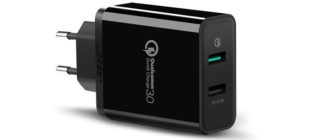Several years ago, this question could be answered unambiguously. Such a possibility is not provided for in the protocol specifications. In 2015, the situation has changed. The first laptop capable of charging via the USB port was released by Apple. Macbook with a screen of 12 inches had only one universal port for connecting peripherals and recharging.
The new USB type C standard allowed for this opportunity. After the first wave of criticism, other electronics manufacturers appreciated the versatility of the solution and released models with similar characteristics.
Content
Can I charge my laptop via USB port
Initially, the USB standard was designed to simplify the connection of external devices. The issue of supplying power through it was far from the first place. The initial specifications included a current pass of 0.15 A and a power of 0.75 W at a nominal voltage of 5 V. This was enough to ensure the operation of the mouse or keyboard, but no more.
By the specifications of the second generation, the power of the transmitted current increased to 0.5 A. This was already enough to power external hard drives. USB 3.0 provided a standard current of 0.9 A with the possibility of amplification up to 1.5 A. It is this current that is enough to charge a mobile phone.
Thus, before the introduction of the USB-C standard, it was not about powering the computer, but about the ability to power external devices. In other words, you cannot charge a laptop through a regular port.
Which laptops can be charged via USB
Based on the foregoing, it becomes clear that charging a laptop using USB is only possible if it is equipped with a Type C connector. However, it is not so simple here. The main task of the USB interface is still to provide peripheral connectivity and high data transfer speed. The power supply capability is regulated by a separate Power Delivery specification. This is one of the protocols for alternative features embedded in the Type C connector.
For compatibility, the new standard supports five different energy profiles. When connecting any external device, the minimum one is used by default, with a current strength of up to 2 A and a rated voltage of 5V. After exchanging data provided by the Power Delivery specifications, the source and the recipient will find out if a higher voltage is supported. If the answer is yes, the profile changes to the maximum possible for the connected device.
Which laptops cannot charge via USB
So, the presence of a USB-C port on a laptop does not guarantee the possibility of charging it with a low Power Delivery profile. Consider their parameters in more detail:
- voltage 5V, current up to 2A, power up to 10 W;
- voltage 5-12V, current up to 1.5-2A, power up to 18 W;
- voltage 5-12V, current up to 1.5-3A, power up to 36 W;
- voltage 12-20V, current up to 3A, power up to 60 W;
- voltage 12-20V, current 4.75-5A, power up to 100 watts.
To ensure laptop battery power, at least a third PD profile is required, which is able to provide the required power and current strength.
How to determine the purpose of a USB type C port
The easiest way to correctly determine the purpose of the ports is to study the documentation of the laptop. Any manufacturer always gives their list and functionality. External marking is approved by the international consortium USB-IF, but is not always applied correctly or in full.
If you have multiple Type C ports, the one intended for charging should have a standard logo in a dark rectangular frame. The left side of the frame is convex, and the right side is concave.
On the right side, a rectangle is additionally applied without one long line facing outward from the logo. The specification stipulates that for USB 3.1 Gen 2, additional letters and numbers Super Speed Plus (SS and 10) are additionally applied.
For simplicity, manufacturers sometimes apply a stylized image of an electric plug or battery next to the charging port. Some models are equipped with a power indicator light; it can also be used to determine the main purpose of the connector.
The consequences of connecting charging via regular USB
Such an error would not cause detrimental consequences if a “native” power supply unit and a certified cable were used, which was supplied with the laptop. The protection provided by the Power Delivery protocol will work and the USB-C port will refuse to accept external power not intended for it.
Very different consequences can be expected when using cheap products from the Middle Kingdom. What the Chinese comrades will save on is unknown. If this turns out to be protection, then at best you will burn out the connector, and at worst, completely burn the motherboard.
Stayed the questions or have something supplement article? Write about it in the comments. This will make the article more complete and useful.








